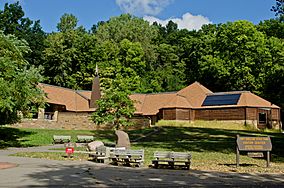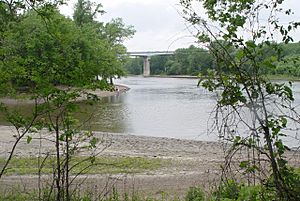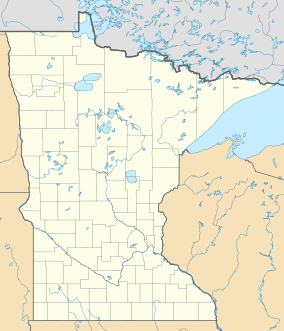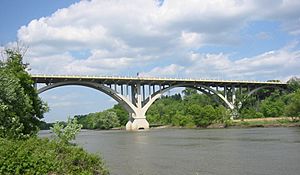Fort Snelling State Park facts for kids
Quick facts for kids Fort Snelling State Park |
|
|---|---|

Thomas C. Savage Interpretive Center
|
|
| Location | Minnesota, United States |
| Area | 2,931 acres (11.86 km2) |
| Elevation | 699 ft (213 m) |
| Established | 1962 |
| Named for | Fort Snelling |
| Governing body | Minnesota Department of Natural Resources |
Fort Snelling State Park is a special park in Minnesota, United States. It sits where the Mississippi River and Minnesota River meet. For hundreds of years, this area has been very important to the Mdewakanton Dakota people. They believe it is the center of the earth.
The park opened in 1962. It is named after the old Fort Snelling, which was built way back in 1820. The fort itself is looked after by the Minnesota Historical Society. Most of the park protects the forests, rivers, and lakes found in the low areas near the river bluffs. Both the park and the historic fort are part of the Mississippi National River and Recreation Area. This is a site managed by the National Park Service.
Every year, about 400,000 people visit Fort Snelling State Park. You can find the restored fort there, along with a visitor center. The park has 18 miles (29 km) of trails for cross-country skiing and hiking. There are also 5 miles (8.0 km) of trails for biking. These trails connect to other cool places nearby. These include the Minnesota Valley National Wildlife Refuge and Minnehaha Park. You can also connect to bigger trail systems like the Grand Rounds National Scenic Byway and the Big Rivers Regional Trail.
Minnesota State Highway 55 goes over the park on the Mendota Bridge. Also, many airplanes flying to and from the Minneapolis–Saint Paul International Airport pass right over the park.

Contents
Exploring the Park's Landscape
The low-lying areas where the rivers meet are home to a special kind of forest. You'll find trees like cottonwood and silver maple. There are also plants like wood nettle and jewelweed.
The park also has marshes, quiet backwater lakes, and wet grassy areas. Many animals live here. You might see white-tailed deer, fox, woodchuck, and skunk. Turkeys and coyotes also roam the park. If you're lucky, you might spot some reptiles. These include snapping turtles, painted turtles, and the harmless western fox snake.
A Look Back at Fort Snelling's History
Long ago, the Mdewakanton Dakota people lived in this area. They believed the spot where the Mississippi and Minnesota rivers meet was the center of the world.
In 1805, an explorer named Lieutenant Zebulon Pike met with the Mdewakanton people. They met on the island between the two rivers. Pike arranged to buy land along the bluffs. This treaty site is now known as Pike Island. The famous Fort Snelling was built on this land between 1820 and 1825. You can learn more about the fort in its own article.
The soldiers at Fort Snelling used the low river valley for many things. They had gardens, raised animals, and stored boats there. After a conflict in 1862, many Dakota people were held in a camp in this area during the winter of 1862–1863. It was a very difficult time, and many became sick or died before they were moved to Nebraska.
Saving the Fort and Creating the Park
In the 1950s, there were plans to build a freeway and bridge right over the fort. This made many people worried. Russell W. Fridley, who was in charge of the Minnesota Historical Society, called a meeting. People wanted to find a way to save the fort.
Eventually, the state agreed to build a tunnel under the fort instead. This way, the old buildings would be safe. In 1960, a landscape architect named A.R. Nichols drew up plans for a large park. This plan helped create the park we see today. Thomas C. Savage became very interested in the idea. He contacted U.W. Hella, the State Parks director. Hella encouraged Savage to start a group of interested citizens. This group became the Fort Snelling State Park Association. They worked hard to raise money and support for the park.
While many people wanted to save the fort, some landowners were not happy. They felt the government wasn't offering enough money for their land. So, the Park Association started raising money privately to buy some of the land. Another question was whether the U.S. government would give the fort property to the state.
On the last day of the 1961 legislative session, money was set aside for the park. The park's first boundaries were much smaller than they are now. On October 29, the federal government gave 320 acres (1.3 km2) of land to Minnesota. This included parts of the fort. The park officially opened on June 3, 1962.
Restoring the Historic Fort
Work to restore the fort began as early as 1957. With the park established, these efforts gained new energy. Old building plans were found in the National Archives. The state government regularly provided money for the project until 1979.
Special limestone was used to match the original building material. This stone came from land owned by the City of Saint Paul. Eventually, the other half of the fort was also given to the park. This part had been used by the United States Department of Veterans Affairs. Now, the entire fort could be restored.
Many parts of the fort were either repaired or rebuilt to look like they did in the 1800s. These included walls, the round tower, barracks (where soldiers lived), the commandant's house, and the gatehouse. Workers even copied the way the original stone blocks were put together.
In 1970, a swimming beach opened in the park. This made the number of visitors go up by 75%! An interpretive center opened in 1974. This was the first center in Minnesota's state park system that was open all year. Even without a place to camp, Fort Snelling State Park is one of the most visited state parks in Minnesota almost every year.
Fun Activities at Fort Snelling State Park
There are many ways to enjoy Fort Snelling State Park!
- Bicycling: You can ride on 5 miles (8.0 km) of paved trails. These trails connect to other paved trails in the area. There are also 10 miles (16 km) of gravel trails.
- Boating: There's a public boat ramp on the Minnesota River near the picnic area. You can also use canoes to explore the lakes and rivers.
- Cross-country skiing: In winter, enjoy 12 miles (19 km) of groomed ski trails.
- Fishing: You can fish in the lake and rivers. There's a fishing pier on Snelling Lake.
- Hiking: Explore 18 miles (29 km) of hiking trails throughout the park.
- Learning and Discovery:
- Visit the Thomas C. Savage Visitor Center. It has exhibits and programs all year round. The Minnesota Department of Natural Resources runs it.
- Take tours of the historic Fort Snelling. There's a separate fee for these tours. The Minnesota Historical Society runs them.
- Sports:
- The Minneapolis Parks and Recreation department has a nine-hole golf course. They also have a sports field west of the fort.
- There are 2 playgrounds for kids, one by the beach and one by the picnic area.
- You can borrow beach volleyball equipment from the park office.
- Swimming: Enjoy swimming at the beach on Snelling Lake.
- Special Events: The Fort Snelling Memorial Chapel, built in 1926, can be reserved for weddings and funerals.
Please note that there is no camping at Fort Snelling State Park. It's a day-use park, open from 8 AM to 10 PM.
Images for kids







